Larval Yellow Perch Studies
Yellow perch larval sampling is conducted in tidal rivers in the spring beginning in early March and continuing through April. Conical, fine-mesh nets are towed behind a boat for 2 minutes and the nets are examined to determine if Yellow Perch larvae are present. Sampling is done once or twice a week at multiple sites. The proportion of tows with larvae is compared to historical estimates from other rivers with watersheds at different levels of development to determine how watershed development impacts their Yellow Perch populations.
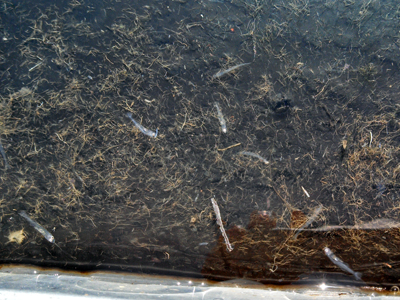
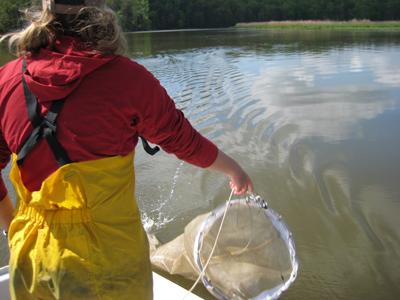
Pictured: Yellow Perch larvae in a sample (left) and Yellow Perch eggs in Mattawoman Creek (right).
Stream Anadromous Fish Spawning Study
This study primarily focuses on understanding how urbanization limits stream spawning habitat for anadromous fish, fish that come from the Chesapeake Bay or ocean. In order to assess the habitat change, fish eggs and larvae are sampled using a fine-mesh net attached to a square frame on a pole held in the water for 5 minutes in several tributaries. These samples are sorted identify the presence and absence of anadromous fish (Blueback Herring, Alewife, Hickory Shad, American Shad, and White Perch) spawning. The proportion of eggs and larvae (combined) in a species group is compared for streams with watersheds at different levels of development (rural to suburban). New for 2025 – eDNA sampling will be added to the sampling regime to determine if it can be used as a cost-effective rapid assessment tool to determine the presence and absence of anadromous fish.
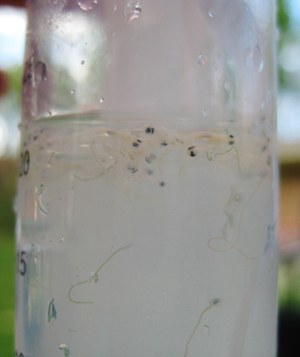



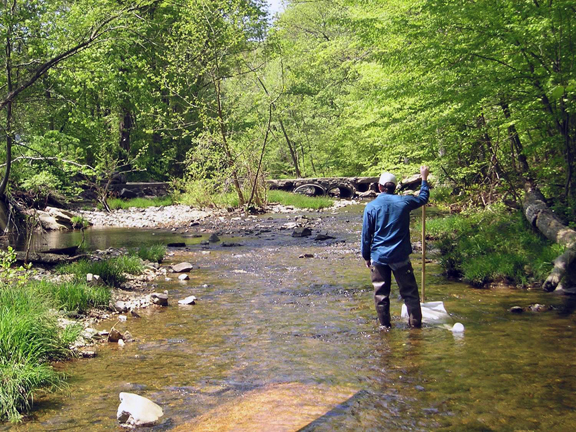
Pictured: Net sampling and ichthyoplankton sample (top) and eDNA sampling (bottom)
Striped Bass Egg and Larvae Habitat Study
Striped Bass egg sampling is conducted in tidal rivers in the spring beginning in late March and continuing through early May. Fine-mesh, conical nets are towed behind a boat for 2 minutes and the nets are examined to determine if Striped Bass eggs are present. Sampling is done twice a week and around 50-100 samples are collected. The proportion of tows with eggs is compared to historical data (back to 1955) to determine the spawning status of Striped Bass. Water quality data are also collected: salinity, conductivity (a more sensitive measure of salinity for freshwater), pH (a measure of acidity), oxygen, and temperature. These water quality data were collected in past surveys and provide a record to look at long-term changes.

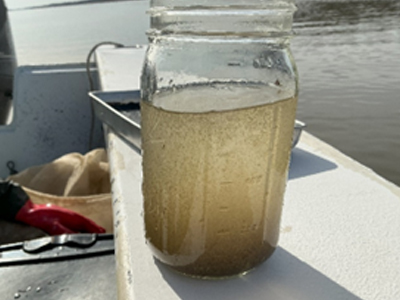
Pictured: Sampled collected full of detritus and ichthyoplankton (left) and jar full of copepods (right).
Larval Striped Bass Feeding Study
How well fish larvae feed on zooplankton is a foundational hypothesis for explaining why year-classes vary in strength. Striped Bass larvae were collected for this study in 2023 and 2024 (and will be collected in 2025). The guts were analyzed for feeding success and food content. This study investigates the feeding rates of first-feeding larvae Striped Bass on copepods and cladocerans. Striped Bass larvae were collected by a midwater trawl and retained for lab analysis. In the lab, Striped Bass larvae were processed to determine if there was food present in their guts and the composition of their diet.

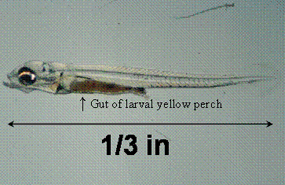
Pictured: Midwater trawl being towed (left) and Striped Bass larvae with a cladoceran in the guts (red arrow; right).
Resident Striped Bass Forage Study
How much forage is there and is it enough? These are important questions for fisheries managers. Staff work with Cooperative Oxford Lab (https://dnr.maryland.gov/fisheries/ pages/oxford/index.aspx) fish health biologists to analyze the stomach contents of resident Striped Bass (11 to 28 inches) in Maryland’s portion of the Chesapeake Bay. Striped Bass are caught for a disease survey in fall, and once processed for disease information, they then cut open to analyze stomach contents. Individual prey items in the stomach are identified and measured/weighed. These measures are used to determine Striped Bass condition, feeding success, and diet composition.
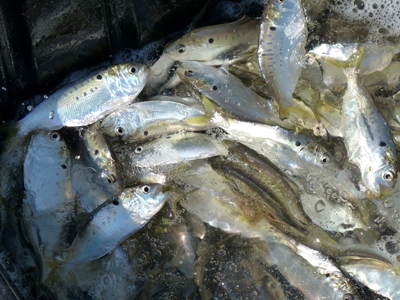
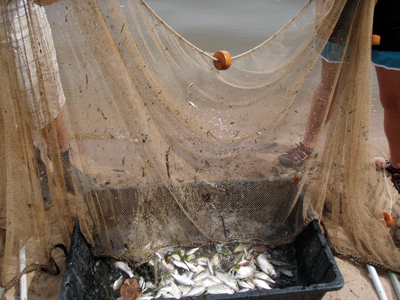
Pictured: Stomachs and contents of resident Striped Bass (both pictures) and Atlantic Menhaden in stomach (right).
Estuarine Fish Community Sampling Study
Fisheries Ecosystem Assessment Division is evaluating nursery and adult habitat of recreationally important finfish in subestuaries of the Chesapeake Bay to see how land use (development, agriculture, forest, and wetlands) impact fish habitat. Development and agriculture create different ecosystems than natural lands and we need to understand how these watershed changes impact fish habitat and fisheries. We sample sites in Bay subestuaries (tributaries of the main Bay) using otter trawls and beach seines. Beach seines sample shallow water habitat and the trawls are towed in the deeper channel adjacent to shore. Sites are sampled once every two weeks during July through September. Target species are Striped Bass, Yellow Perch, White Perch, Alewife, Blueback Herring, American Shad, Hickory Shad, Spot, Atlantic Menhaden, Bay Anchovy, Spottail Shiner, Silvery Minnow, and Gizzard Shad. Juveniles and adults are separated and counted, and measurements are taken from select species. In addition to beach seining and trawling, water quality measurements (dissolved oxygen, conductivity, salinity, pH, Secchi) are taken at each site. Of particular importance is bottom dissolved oxygen, which is significantly impacted by development in mesohaline subestuaries.
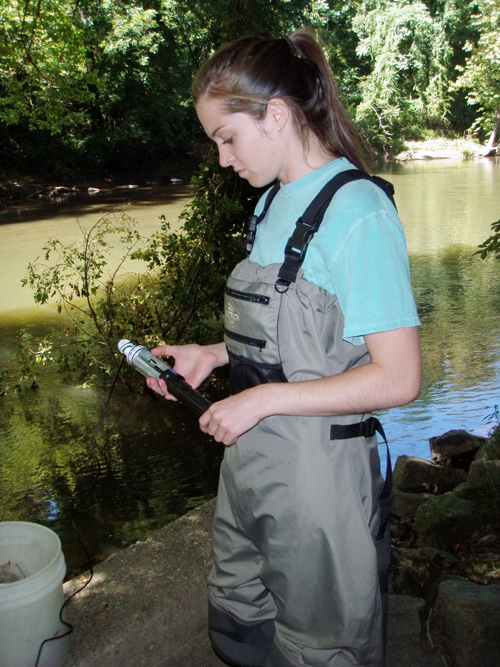
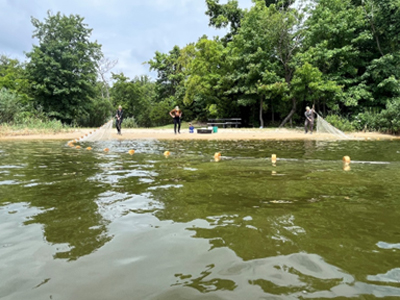
Pictured: Taking water quality measurements (left) and pulling in a beach seine (right).

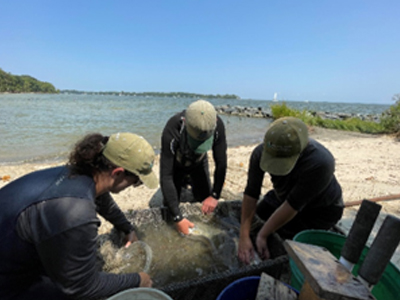
Pictured: Bottom trawl sample being sorted and counted (left) and beach seine sample being sorted and counted (right).